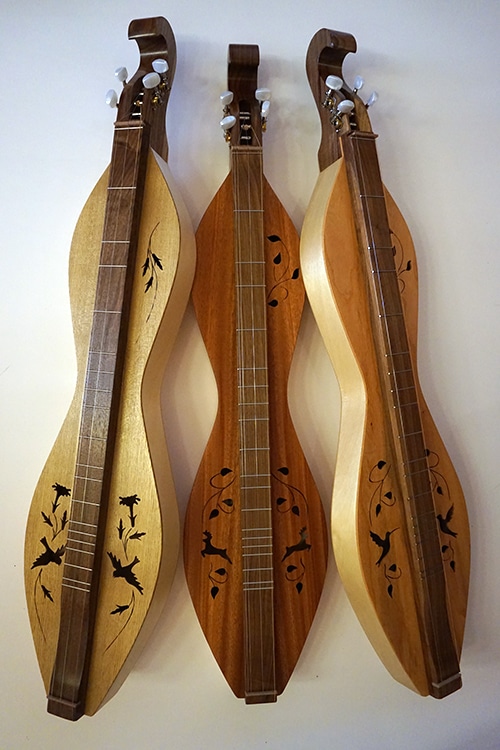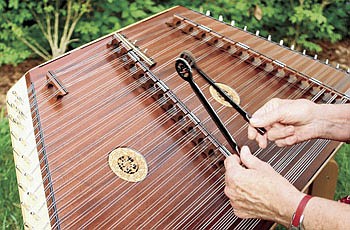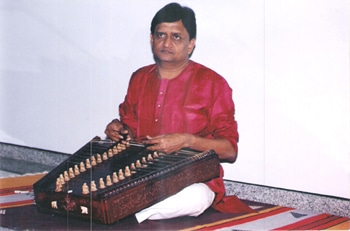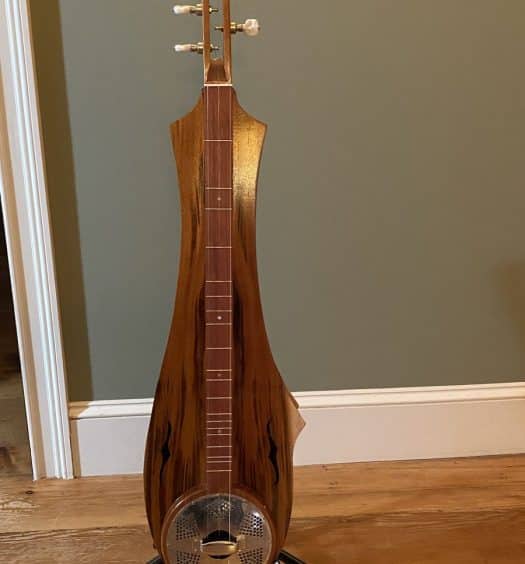When comparing the dulcimer vs santoor (also known as the “sandoor“), both are acoustic stringed musical instruments with distinct characteristics and origins. Although they share some similarities, such as being played by striking the strings, there are some notable differences that set them apart.
Without further ado, let discuss the key differences between the two instruments.
Dulcimer vs Santoor – An Introduction
When we talk about dulcimers, two styles generally come to mind. The first style is the Appalachian or “mountain” dulcimer which is often played on the lap. This is traditionally a narrowly-shaped, fretted acoustic instrument with strings that are strummed to produce sound – either with fingers or with a pick (or “plectrum”). Sometimes a noter is used to hold down the melody strings while playing.
The second style is the hammered dulcimer, which is a multi-stringed acoustic instrument whose strings are struck with small hammers. The hammered dulcimer is typically trapezoidal in shape and played on a solid surface or table. Both styles produce the “sweet” dulcet sounds that are characteristic of dulcimers.
While there are other less played varieties of dulcimer instruments, including the dulcimer guitar, the stick dulcimer, the banjo dulcimer, and the resonator dulcimers, the most popular styles today are the mountain and hammered dulcimers.

Source: cedarcreekdulcimers.com

Origins and History
When comparing the dulcimer vs santoor, let’s first start off with their history.
The hammered dulcimer has a rich history that can be traced back to ancient civilizations, particularly in the Middle East and Persia. It has different variations and names across various cultures, such as the hammered dulcimer, mountain dulcimer, and santoor.
In contract, the history of the mountain dulcimer has been traced mostly to European roots from the early 19th century. The dulcimer has been used in traditional folk music and has evolved and adapted to different musical styles and regions.
The santoor, on the other hand, is a traditional stringed instrument originating from Iran and India. It is often associated with Persian and North Indian classical music. The santoor has a history that dates back several centuries and has been played in various forms and variations across different regions and cultures.

Construction
The hammered dulcimer and santoor share similarities in terms of instrument construction.
Both are acoustic instruments that are traditionally constructed of a wooden sound board which tends to be trapezoidal in shape. The hammered dulcimer features multiple strings that are usually arranged in courses or pairs. The strings are struck with small hammers or mallets, creating a percussive and melodic effect. Due to the large number of strings, tuning is often a challenge.
Read More >> How to Choose a Hammered Dulcimer
Read More >> Ultimate Guide to Building a Hammered Dulcimer
Similar to the hammered dulcimer, the santoor also has a rectangular or trapezoidal shape with a wooden body and a soundboard. It features a series of metal strings stretched over bridges. The strings are struck with a pair of wooden mallets known as “mezrab.” The santoor’s construction allows for a wide range of pitch and tonal possibilities.
Playing Technique
When in comes to the dulcimer vs santoor, there are many notable similarities in terms of playing technique.
In the hammered dulcimer, the player uses small hammers or mallets to strike the strings, creating a percussive and melodic effect. In other dulcimer variations, such as the mountain dulcimer, the strings are plucked or strummed with the fingers or a pick. The dulcimer allows for both melodic playing and chordal accompaniment.
Like the hammered dulcimer, playing the santoor involves striking the strings with wooden mallets (mezrab). The mallets are held in the player’s hands, and the strings are struck in a rapid and rhythmic manner. The santoor player can produce melodic patterns, ornamentation, and intricate rhythms. The technique of striking the strings and the use of different striking techniques (such as glissandi and vibrato) are crucial aspects of playing the santoor.
Below is an excellent introductory video to the santoor by The World Drum Club. Please like their video and subscribe to their channel.
Musical Styles and Repertoire
In terms of musical style and repertoire, there are distinct differences when comparing the dulcimer vs santoor.
The dulcimer is commonly associated with folk and traditional music, particularly in the Appalachian region of the United States. It has a distinctive sound that lends itself well to playing traditional tunes and creating a melodic and rhythmic foundation. The dulcimer has also been adapted to contemporary genres, including folk-rock and world music.
The santoor is primarily associated with Persian and North Indian classical music. It is often featured as a solo instrument or as part of an ensemble. The santoor’s versatility allows for the exploration of complex melodic patterns, intricate ornamentation, and rhythmic structures. It is also used in folk and devotional music in the regions where it is popular.
Dulcimer vs Santoor – Summary
Both the hammered dulcimer and santoor are acoustic, stringed instruments played by striking the strings with mallets. While they differ slightly in terms of origin, construction, playing technique, and musical styles they otherwise are very similar.
The dulcimer’s various forms and adaptability make it suitable for folk and traditional music, while the santoor is deeply rooted in Persian and North Indian culture.




